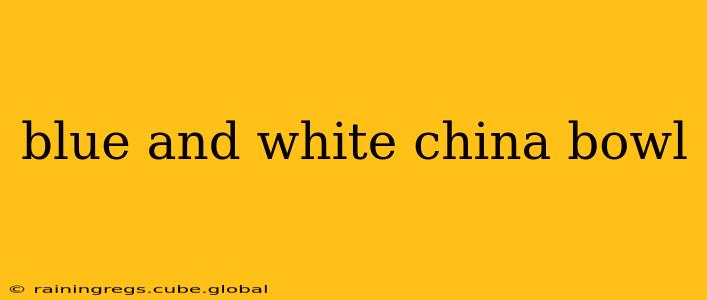Blue and white china bowls represent a captivating blend of artistry and history. From delicate porcelain teacups to substantial serving bowls, these pieces evoke a sense of elegance and tradition. This guide delves into the world of blue and white china bowls, exploring their history, identifying characteristics, caring for them, and appreciating their enduring appeal.
What are Blue and White China Bowls Made Of?
Blue and white china bowls are typically made from porcelain, a type of ceramic known for its translucence and durability. The "china" designation refers to porcelain originating from China, where the art of creating these beautiful bowls flourished for centuries. However, many countries now produce exquisite blue and white porcelain. The specific clay composition and firing techniques influence the final look and feel of the bowl, resulting in variations in texture, weight, and overall aesthetic. Some might be thinner and more delicate, while others are heavier and more substantial.
How Can You Identify Authentic Blue and White China?
Identifying authentic blue and white china can be challenging, particularly with the prevalence of reproductions. However, several key factors can help distinguish genuine antique pieces from more modern counterparts. Look for:
- Underglaze blue: Authentic pieces often feature cobalt blue pigment applied under the glaze, giving it a characteristic soft, slightly diffused appearance. Overglaze blue, common in later reproductions, tends to be brighter and more intense.
- Markings: Examine the base of the bowl for maker's marks, dates, or other identifying symbols. These can provide valuable clues about the bowl's origin and age. Researching these marks can help determine authenticity and value. Be aware that forgeries sometimes include false markings.
- Painting style: The style of painting can indicate the period and origin. Look for subtle brushstrokes, variations in color intensity, and the overall composition of the design. Expert knowledge or consulting with an appraiser is often helpful in this regard.
- Condition: Chips, cracks, and repairs can impact the value of an antique bowl. However, these imperfections can also be a part of the piece's story and charm.
Where Can I Find Blue and White China Bowls?
Blue and white china bowls can be found in various places:
- Antique shops and flea markets: These are excellent places to discover unique and potentially valuable pieces. Be prepared to do some research and possibly haggle on price.
- Online marketplaces: Websites like eBay and Etsy offer a vast selection of blue and white china bowls, ranging from affordable reproductions to high-end antiques. Be cautious of fraudulent listings and thoroughly investigate sellers' reputations.
- Auction houses: Auction houses regularly feature blue and white china bowls, often attracting serious collectors and offering a chance to bid on rare or high-value items.
- Estate sales: Estate sales can be a treasure trove for finding unique and affordable pieces.
How Do I Clean and Care for My Blue and White China Bowl?
Proper cleaning and care are essential for preserving the beauty and value of your blue and white china bowl:
- Hand washing: Always hand wash your blue and white china bowls with a mild detergent and lukewarm water. Avoid abrasive cleaners or scouring pads, which can damage the delicate surface.
- Gentle drying: Pat the bowl dry with a soft cloth to prevent water spots. Avoid placing it in a dishwasher, which can subject it to harsh detergents and high temperatures.
- Safe storage: Store your bowls in a cool, dry place, ideally wrapped individually in soft tissue paper or bubble wrap to prevent chipping or scratching.
What are Some Popular Designs of Blue and White China Bowls?
The designs on blue and white china bowls are incredibly varied and depend heavily on the era and origin of the piece. Popular motifs include:
- Floral patterns: Flowers like peonies, chrysanthemums, and lotuses are frequently featured, often intertwined with other elements.
- Landscapes: Picturesque landscapes often depict idyllic scenes of nature.
- Birds and animals: Depictions of birds, dragons, and other animals add a sense of movement and life to the designs.
- Geometric patterns: Stripes, dots, and other geometric designs offer a more minimalist aesthetic.
Are Blue and White China Bowls Valuable?
The value of a blue and white china bowl depends on several factors, including:
- Age: Older pieces, especially those from renowned makers, tend to be more valuable.
- Rarity: Unique or uncommon designs and patterns command higher prices.
- Condition: The condition of the bowl significantly impacts its worth. Damage reduces value, while excellent condition enhances it.
- Maker: Renowned makers or studios significantly influence value.
- Provenance: A clear history or chain of ownership can increase value.
This guide provides a starting point for appreciating the beauty and history of blue and white china bowls. Further research and perhaps consultation with an expert can deepen your understanding and help you discover the unique story behind your own treasured piece.
